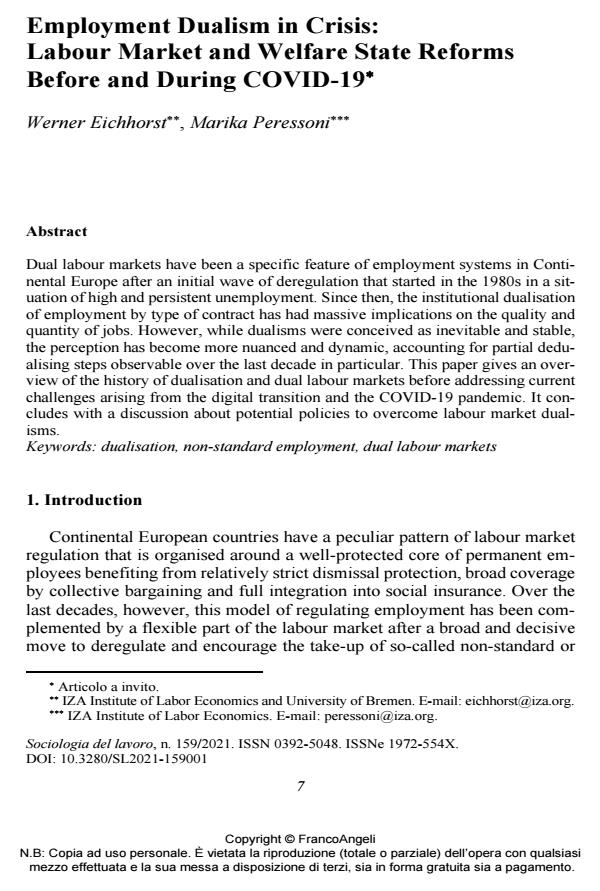Employment Dualism in Crisis: Labour Market and Welfare State Reforms Before and During COVID-19
Titolo Rivista SOCIOLOGIA DEL LAVORO
Autori/Curatori Werner Eichhorst, Marika Peressoni
Anno di pubblicazione 2021 Fascicolo 2021/159
Lingua Inglese Numero pagine 21 P. 7-27 Dimensione file 246 KB
DOI 10.3280/SL2021-159001
Il DOI è il codice a barre della proprietà intellettuale: per saperne di più
clicca qui
Qui sotto puoi vedere in anteprima la prima pagina di questo articolo.
Se questo articolo ti interessa, lo puoi acquistare (e scaricare in formato pdf) seguendo le facili indicazioni per acquistare il download credit. Acquista Download Credits per scaricare questo Articolo in formato PDF

FrancoAngeli è membro della Publishers International Linking Association, Inc (PILA)associazione indipendente e non profit per facilitare (attraverso i servizi tecnologici implementati da CrossRef.org) l’accesso degli studiosi ai contenuti digitali nelle pubblicazioni professionali e scientifiche
Dual labour markets have been a specific feature of employment systems in Con-tinental Europe after an initial wave of deregulation that started in the 1980s in a situation of high and persistent unemployment. Since then, the institutional duali-sation of employment by type of contract has had massive implications on the quality and quantity of jobs. However, while dualisms were conceived as inevita-ble and stable, the perception has become more nuanced and dynamic, account-ing for partial dedualising steps observable over the last decade in particular. This paper gives an overview of the history of dualisation and dual labour markets before addressing current challenges arising from the digital transition and the COVID-19 pandemic. It concludes with a discussion about potential policies to overcome labour market dualisms.
Il mercato duale del lavoro è stato una caratteristica specifica dei sistemi occupazionali dell’Europa continentale dopo una prima ondata di deregolamentazione iniziata negli anni ‘80 in una situazione di disoccupazione elevata e persistente. Da allora, la dualizzazione istituzionale dell’occupazione per tipologia di contratto ha avuto enormi implicazioni sulla qualità e quantità dei posti di lavoro. Tuttavia, mentre i dualismi sono stati concepiti come inevitabili e stabili, la percezione è diventata più sfumata e dinamica, con parziali passi deduttivi osservabili soprattutto nell’ultimo decennio. Questo articolo offre una panoramica della storia della dualizzazione e del mercato duale del lavoro prima di affrontare le sfide attuali derivanti dalla transizione digitale e dalla pandemia COVID-19. Si conclude con una discussione sulle potenziali politiche per superare i dualismi del mercato del lavoro
Parole chiave:Dualizzazione, mercato del lavoro, occupazione non standard, pandemia Covid-19, Europa continentale
Werner Eichhorst, Marika Peressoni, Employment Dualism in Crisis: Labour Market and Welfare State Reforms Before and During COVID-19 in "SOCIOLOGIA DEL LAVORO " 159/2021, pp 7-27, DOI: 10.3280/SL2021-159001